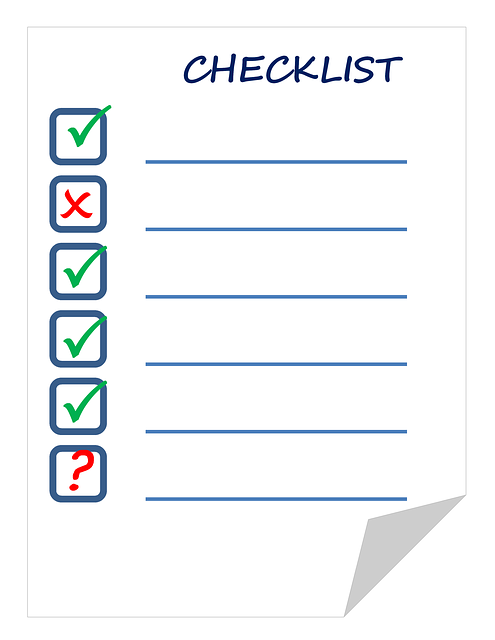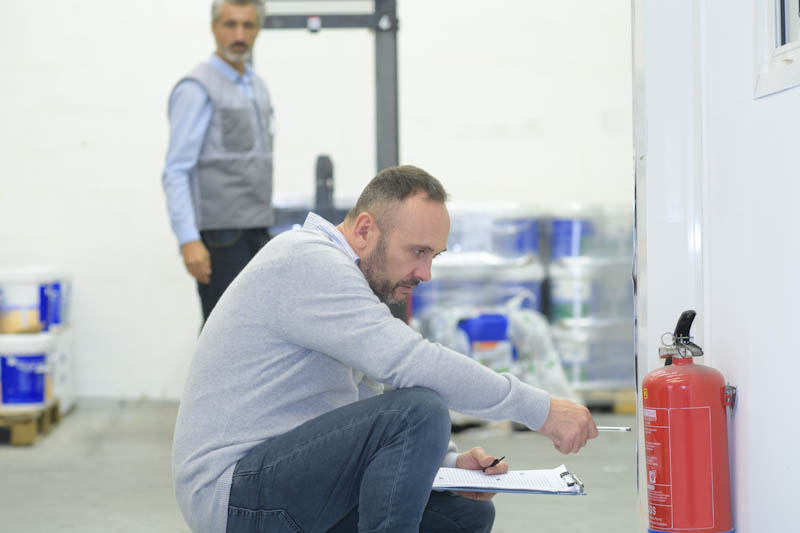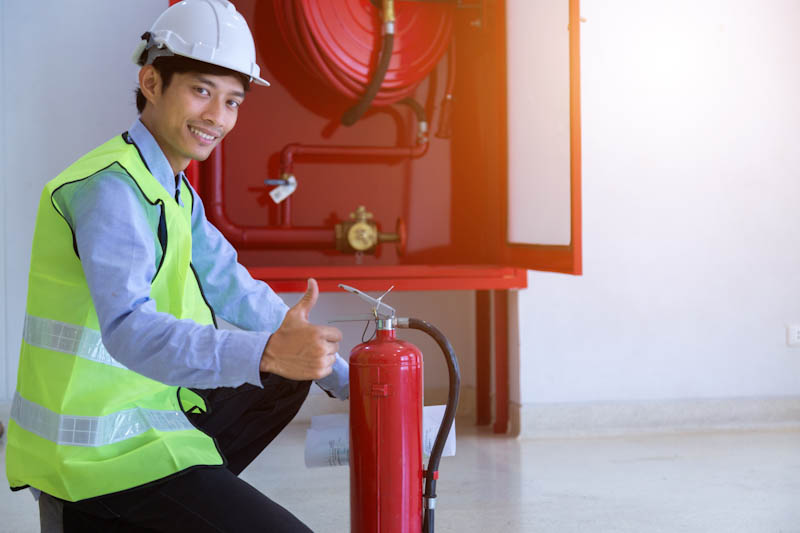Fire safety is crucial for any business. One of the essential components of fire safety is ensuring that fire extinguishers are in proper working order. Regular checks are essential to guarantee the reliability of fire safety equipment. We will explore the importance of checks, extinguisher types, the inspection process, the frequency of checks, and common issues. By the end of this ‘Fire Extinguisher Checks UK: A Comprehensive Guide’ article, you will have a solid understanding of fire extinguisher maintenance in the United Kingdom.
Understanding the Importance of Fire Extinguisher Checks
The safety of occupants, employees, and visitors should always be the top priority when it comes to fire safety. Extinguishers play a crucial role in controlling and extinguishing fires, providing a first line of defence in case of an emergency. However, the effectiveness of extinguishers can be compromised if they are not properly maintained.

Regular extinguisher checks are essential to confirm that the devices are readily accessible, fully charged, and free from any defects.
Optimising your fire safety equipment such as extinguishers ensures they are reliable and functional, ready to be used in a time of need. Ignoring maintenance can have catastrophic consequences, significantly increasing the potential damage and risk to life in the event of a fire.
The Role of Fire Extinguishers in Safety
It is important to understand the vital role these devices play in ensuring safety. Fire extinguishers are designed to suppress or extinguish small fires, preventing them from spreading and causing further damage. They are an essential tool to buy time, allowing individuals to escape a building or to control smaller fires before emergency services arrive.
Without fire extinguishers or with faulty ones, the ability to respond effectively when a fire breaks out is severely compromised. Regular monthly visual inspections and an annual fire extinguisher service are essential to ensure that these devices are ready and able to fulfil their role in protecting lives and property.
Legal Requirements for Fire Extinguisher Maintenance
Fire safety in the UK is governed by legislation to minimise the risks and ensure proper fire prevention measures are in place. The Regulatory Reform Fire Safety Order 2005 outlines the legal requirements for fire safety, including extinguisher maintenance.
Under this order, it is the responsibility of the “Responsible Person” to ensure that extinguishers are properly maintained and regularly checked. Failure by a competent person to comply with this legal requirement can result in severe penalties and, more importantly, put lives at risk.
Accessibility
Firstly, the accessibility of extinguishers is of utmost importance. Extinguishers should be easily visible and within reach, ensuring that they can be quickly accessed in case of an emergency. This means that they should not be obstructed by furniture, equipment, or any other objects. This ensures they are correctly located.
Charged
They also need to be fully charged to be effective. A fully charged extinguisher contains the necessary amount of extinguishing agent to combat a fire. Regular checks should be conducted to ensure that the pressure gauge on the extinguisher indicates that it is fully charged. If the pressure gauge shows a lower reading, it may indicate it needs to be recharged.
Free from Defect
Extinguishers should be free from any defects that may hinder their functionality. This includes checking for visible signs of damage, such as dents, corrosion, or leakage. Any damaged extinguishers should be immediately replaced or repaired to ensure their effectiveness in case of a fire.
It is also important to note that different types of extinguishers are designed to combat specific types of fires. For example, water-based extinguishers are suitable for fires involving ordinary combustible materials, while CO2 extinguishers are effective for electrical fires. Checks should include verifying that the correct type of extinguisher is in place for the specific hazards present in the building.
Regular Checks
Regular checks should be carried out by responsible person or individuals who are knowledgeable about the different types of extinguishers and their maintenance requirements. These checks should be documented, including the date of the check, the name of the responsible person for conducting the check, and any actions taken, such as recharging or replacing extinguishers.
Extinguisher visual inspections are essential for ensuring the safety of occupants, employees, and visitors. By conducting visual inspections, extinguishers can be maintained in optimal condition, ready to be used in case of a fire. Compliance with legal requirements and proper maintenance practices can significantly reduce the risks associated with fires and protect lives and property.
Types of Fire Extinguishers and Their Specific Checks
There are several types of fire extinguishers, each designed to tackle different types of fires. It is essential to understand the specific checks required for each type to ensure their effectiveness. Let’s explore some of the most common types of fire extinguishers and their maintenance requirements:
Water Extinguishers
Are suitable for fighting fires involving solid combustibles, such as paper, wood, and fabric. Regular checks for water extinguishers include ensuring the extinguisher is full and has not been discharged or tampered with. The pressure gauge should be within the recommended range, indicating that the internal pressure is sufficient for effective use.
Additionally, it is important to inspect the condition of the hose and nozzle. Any signs of wear or damage to service parts should be addressed promptly to ensure proper functionality. The handle and safety pin should also be checked to ensure they are intact and easily accessible in case of an emergency.
Water extinguishers should be stored in a designated place in a location that is easily accessible and visible. It is crucial to keep them away from potential obstructions or clutter that may hinder their quick retrieval during a fire incident.
CO2 Extinguishers
CO2 extinguishers are primarily used to tackle fires involving flammable liquids and electrical equipment. Checks for CO2 extinguishers involve examining the discharge horn and checking for any obstructions or damage. The weight of the extinguisher should also be within the specified range, indicating that it is full and ready for use.
In addition to these checks, it is vital to visually inspect the condition of the pressure gauge and ensure it is functioning correctly. The CO2 extinguisher should be stored in a cool and dry place, away from direct sunlight or extreme temperatures, to prevent any potential damage or decrease in effectiveness.
Moreover, it is recommended to have a trained professional conduct periodic inspections annual servicing and maintenance on CO2 extinguishers to ensure their optimal performance. They can assess the overall condition of the extinguisher, including the integrity of the cylinder and the functionality of the valve.
Foam Extinguishers
Foam extinguishers are effective for fires involving flammable liquids, such as petrol, oil, and paints. Maintenance checks for foam extinguishers include ensuring the pressure gauge is within the recommended range and inspecting the discharge nozzle, ensuring it is clear of any obstructions.
It is important to check the foam concentrate level and ensure it is at the correct pressure range and appropriate level for effective firefighting. The foam extinguisher should be stored upright to prevent the foam from settling or separating, which may affect its performance during an emergency.
Additionally, foam extinguishers should be visually inspected for any signs of corrosion or damage to the cylinder. If any issues are detected during visual inspections, it is important to have the extinguisher serviced or replaced by a qualified professional to ensure its reliability.
Regular training and education on the proper use of foam extinguishers should also be provided to individuals who may need to operate them in an emergency. This will ensure that they are familiar with the operational and safety limits of the equipment and can effectively respond to a fire incident.
The Fire Extinguisher Inspection Process
Proper inspection of fire extinguishers involves a systematic process to verify their condition. This process typically comprises the following steps:
Initial Visual Inspection

The initial visual inspection involves assessing the overall condition and accessibility of the fire extinguisher. This includes checking for any physical damage, ensuring the extinguisher is mounted and correctly located, and ensuring the operating instructions and safety pin are in place.
Detailed Extinguisher Check
During the detailed extinguisher check, each extinguisher is individually inspected to ensure it meets the necessary requirements. This includes examining the pressure gauge, checking the weight, inspecting the extinguisher label for any signs of deterioration, and confirming the presence of a valid inspection tag.
Documentation and Reporting
Documentation is a crucial part of extinguisher checks, providing a record of maintenance activities. After each inspection, it is important to update the inspection log or tag with the date, name of the inspector, and any actions taken. This documentation serves as evidence of compliance with legal requirements and can be used to track the history of each fire extinguisher.
Frequency of Extinguisher Checks
Regular fire extinguisher checks are crucial to ensure their reliability in case of fire. There are two main categories of checks to be performed:
Regular Self-Inspections
Self-inspections should be conducted regularly by the responsible person or any designated competent person within the organisation. These checks typically involve a visual examination of the fire extinguishers. This ensures they are undamaged, accessible, and have not been tampered with. The frequency of self-inspections depends on various factors:
- The type of extinguisher
- The environment it is located in
- The specific requirements outlined in the fire risk assessment
Annual Professional Inspections
Besides regular self-inspections, fire extinguishers need a more thorough inspection by a certified extinguisher technician (typically annual inspections). This involves a qualified engineer thoroughly examining each fire extinguisher, ensuring it meets the necessary standards and is in proper working order. This professional inspection provides an additional layer of assurance and compliance to maintain fire safety standards.
Common Issues Found During Fire Extinguisher Checks
During fire extinguisher checks, certain issues may arise, indicating a need for maintenance or repair. Being aware of these common issues allows for prompt corrective action, to rectify them. Here are some of the most frequently encountered problems:
Pressure Problems
One common issue is low or inconsistent pressure within the fire extinguisher. This can indicate a leak or a faulty seal, compromising the device’s ability to function effectively. Pressure problems should be addressed immediately to ensure the correct pressure and the extinguisher is ready for use when needed.
Physical Damage to Extinguishers
Physical damage, such as dents, cracks, or bent components, can significantly impair the functionality of a fire extinguisher. Damaged extinguishers may not properly discharge their contents, rendering them ineffective in an emergency. Any visible physical damage should be addressed promptly, either by repairing or replacing missing parts of the extinguisher.
Blocked or Damaged Discharge Nozzles
The discharge nozzle is an essential component of a fire extinguisher, responsible for directing the extinguishing agent towards the fire. If the nozzle is blocked or damaged, it can hinder the proper functioning of the extinguisher. Regular checks should include inspecting the discharge nozzle to ensure it is free from debris and in good working condition.
Worn or Obscured Operating Instructions
During an annual service or visual inspection the person responsible should always check the operating instructions are clear and readable.
To Sum Up – Fire Safety & Fire Extinguisher Checks

By implementing regular fire extinguisher checks and promptly addressing any issues discovered, you can ensure the safety and well-being of everyone within your premises. Remember, fire extinguisher maintenance is a legal requirement, and compliance with regulations is crucial for the safety of all occupants. Stay vigilant, stay safe!
Additional Reading
Now that you’ve explored how often should fire extinguishers be visually inspected why not check out the following posts:
Learn when to use carbon dioxide extinguishers with our Which Fire Extinguisher is Best for Electrical Fires?
More Helpful Content
Visit our Homepage
